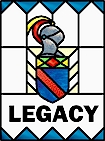 View samples British Legacy
View samples British Legacy
View samples
British Legacy II
Period Styles
Victorian
Edwardian
Art Nouveau
Art Deco
Arts & Crafts
Purchase CD
from Dragonfly Software
Symbolism
Throughout the ages art has been used as a venue to communicate, record and relay cultural values and history.
Stained glass work exhibited an array of motifs, which maintained popularity through out various periods and venues for artistic expression. Much of the symbolism revolves around themes of life, love, religion and power.
Acorns & Oak Leaves
The popularity of this motif peaked during patriotic periods. Acorns &
oak leaves were also used as Heraldic emblems.
Bell
Bells are a symbol of a joyous occasion.
Candle
The candle is a symbol of Christ.
The wax being is His flesh, the wick is His soul, and the light of the
candle, His divinity.
Candlestick
A lit candlestick or burning lamp represents active devotion, watchfulness
and prayer.
Circle
The never ending circle symbolizes eternity.
Crown
A crown is a symbol of power and denotes the
rank of the owner. Crown motifs are also associated with eternity and fidelity.
Dragon
As trade with the orient spread, there was a
marked oriental influence in the art of other cultures. In China
the dragon is
a divine mythical creature, a symbol of prosperity and good fortune.
Fish
The fish is associated with Jesus Christ and the ancient Christian
ritual of Baptism.
Fleur-de-lys
In its heraldic form, the fleur- de- lys is an iris,
which became associated with royalty, especially
in the High Middle Ages.
Heart
The heart symbol, as we know it today,
was popularized by the Victorian era over a hundred years ago. The heart
represents all love including divine love.
Lily
The lily is associated with purity and
innocence.
Peacock
In medieval times the peacock
represented a kingly or knightly demeanor. It is also associated with
vanity, luxury and eternal life.
Pineapple
The pineapple is a symbol for hospitality.
Rose
The rose is a symbol of mystic vision,
beauty, joy and courtly love in the Middle Ages. The Tudor kings of
England used the rose as their national emblem.
Shield
In medieval times the coat of arms was used by knights
as an emblem of identity. After it lost its significance in warfare, it
became a way of recording and displaying family lineage and membership in
the aristocracy.
Ship
The ship stands for hope, marriage and
prosperity. A ship also symbolizes the soul's voyage to a safe haven.
Stars
The eight-point star is the emblem
of Bethlehem; the six-point star is a Jewish symbol, and the five point
star announces the birth of Christ.
Swan
The symbolism of the swan embodies love, purity, and chance.
Because the swan was believed to sing calmly and sweetly as it was dying, it also
represents an ending or comforted death.
Tulip
The tulip is one of the most popular motifs used in
antique stained glass. It symbolizes perfect love as well as the Holy
Trinity.
Wreath
The wreath, often made from
evergreen branches and used as holiday decoration is a symbol for
eternity.